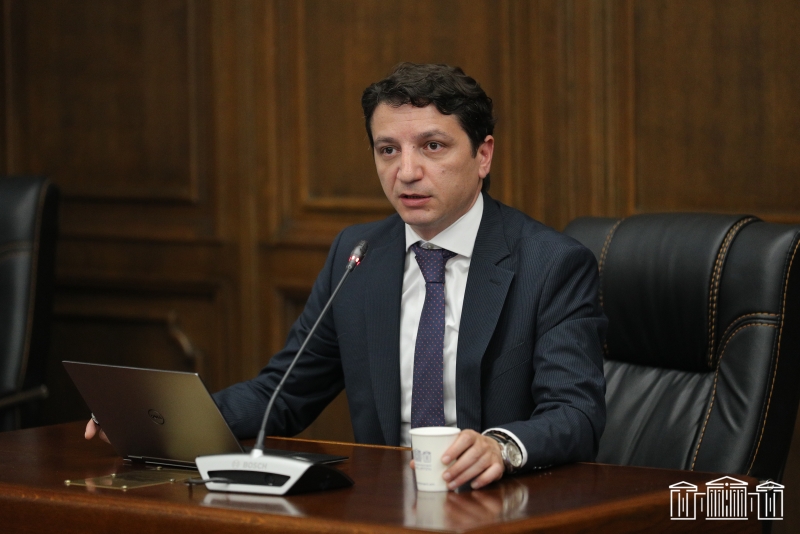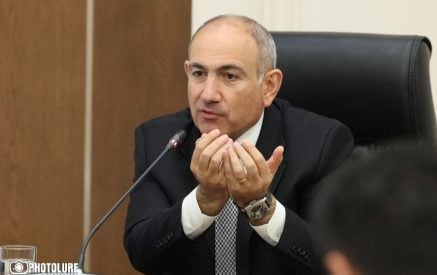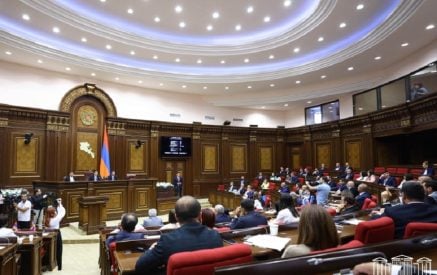We continuously try to improve the culture of our budgeting, planning and implementation, and first of all, is connected with strategies. If we have good strategies, we’ll be able to implement good budgeting. Fortunately, I can say that that the Government programme gave good bases in order to be able to implement distinct, more targeted policies, and it gave its results. At May 29 joint sitting of the NA Standing Committees, the RA Minister of Finance Vahe Hovhannisyan presenting for debate the main macro-economic indicators of the annual report on Implementation of the RA State Budget for 2022, the formation of the budgetary revenues, the tax and customs, the expenditures and the deficit.
Vahe Hovhannisyan informed that in the main partner countries of Armenia essential slow process of economic growth took place. Inflation great environment was observed in the international markets of the raw materials and food products, which had its impact on the inflation in Armenia, though the inflations pressures decreased. The copper average prices of reduced by 5.3% in 2022 towards 2011, the molybdenum prices increased by 27.4%, the oil annual prices increased by 41.7%, and the food products – by 14.3%. In the conditions of the Russian-Ukrainian conflict great inflow of people and capital was noticed. According to the Minister, the export volume to the Russian Federation essentially increased, here the amount of re-export has great share.
In 2022, the number of tourists reached 1 million 666.000, 790.000 out of them from the Russian Federation (RF). The number of tourists, who arrived from other countries also increased. In 2021, the net money transfers increased 2.9 times, which is conditioned by the increase of about 6.8 times of monetary transfers from the RF.
“As a result, at the beginning of the year we targeted 7% economic growth, afterwards during the year while planning the budget we were forecasting 11%, we have 12.6% economic growth, which by absolute number was 8 trillion 497 billion AMD,” the Minister said.
Read also
The services mainly promoted the increase of the economic growth, though the construction also had considerable influence.
12-month inflation was 8.3%, the average inflation – 8.6%.
In the reporting year, the Central Bank raised the re-financing percentage rate by 3%, which had its impact on the RA debt percentage rates.
The AMD has valued against the USD. “We also notice growth of the credit and deposit volumes in case when we neutralize the factor of the dram evaluation factor, though the loan growth is mainly noticed on mortgage credits. The volumes of the state bonds’ distribution volumes sufficiently increased. It’s good for us that the demand exceeds about double the placement indicators,” Vahe Hovhannisyan noted.
The unemployment level decreased by 2.5%, and the amount of the real salary increased by 6.3%. In the state sector the amount of the average salary was 186.000 AMD, and in non-state sector – 256.000 AMD.
The volumes of product export increased by 68.5%, the import – by 58.3%. The foreign direct investments were of unprecedented high growth.
The Minister presented also other indicators.
The budget for 2022 was of 179.5 billion AMD deficit against the planned 22.9 billion AMD.
The loan to Artsakh was 176 billion AMD, which was higher from the planned one. By December 31, the state debt was 4 trillion 185 billion AMD. The current expenditures decreased and the revenues increased due to a number of circumstances.
Vahe Hovhannisyan informed that during the reporting year, the annual plan of the Ministry of Finance was 217 billion AMD, afterwards – the defined plant was 202 billion AMD, the performance – 201.6 billion AMD 0r 99.7%.
The Ministry implemented 4 programmes.
National Assembly of the Republic of Armenia
























































